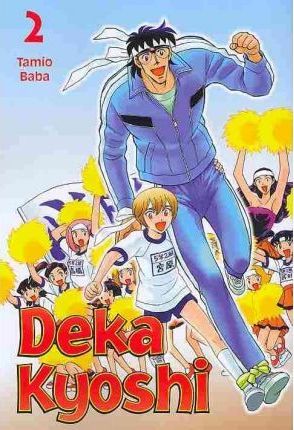Manga Review: Deka Kyoshi Vol. 2 by Tamio Baba
When fourth-grade teacher Ms. Shimizu is found fallen from the roof of her condo, it’s ruled a suicide. But when the police receive a message claiming that someone in her homeroom class was responsible, and that more incidents are to follow, they decide to take action. Massive but kindly police detective Kohei Yamada is sent undercover as the new fifth-grade teacher for Class Two. What secrets will he uncover?

In the first volume, Toyama investigated who seemed to be the most likely suspect, sensitive lad Makoto Miyahara, who was behaving oddly. Makoto turned out to have the gift of seeing “synthe”, a physical representation of a person’s abnormal emotions or psychological state. When the other person’s emotions are relieved, the synthe fades away.
With the aid of Makoto’s special ability, Toyama begins helping his students with their problems, while still searching for the answer to Ms. Shimizu’s death.
This three-volume series was a part of the ill-fated CMX line, and appears to have been attached to a more “desired” manga, Apothecarius Argentum, as part of a package deal. (A lot of the more obscure anime and manga offerings in the U.S. in the late Eighties/early Nineties were sold as “packages” with bigger name products. You want Sailor Moon? You also have to accept a two-part OVA that flopped in Japan.) It appears that the third volume never came out in English.
In this volume, our oversized hero (the title is a slangy way of saying “Police Detective Giant”) deals with a poor boy accused of theft, an nonathletic girl who’s terrified of letting her classmates down on Sports Day, a boy who’s embarrassed to use the school toilet and thus has been holding it in, and a bright kid who’s being pressured to perform even above his own high scholarship skills.
A subplot is a mysterious boy who has been lurking in the background orchestrating events to heighten the student’s psychological distress. Toyama is finally able to confront him in the final chapter of this volume, and learns he was trying to get revenge on Class Two for supposedly causing Ms. Shimizu’s suicide. Except that it’s now clear that wasn’t the case, which leaves the question of what really happened.
The series is very clearly aimed at kids in the 10-12 year old age group, but was rated at “older teen” in the United States because of cultural differences in what is considered appropriate subject matter for children. (For example, there’s a joke implying that Makoto is unusually well-hung for a fifth-grader.)
The art is decent, especially showing its strength in the depiction of different synthe monsters, but the writing is only so-so. This and the preceding volume are mostly of value as a curiosity as they’ve become difficult to find. If you’re interested in a better series about a teacher using his special talents to help students with their difficulties, try Hell Teacher Nube, Great Teacher Onizuka or Assassination Classroom.

